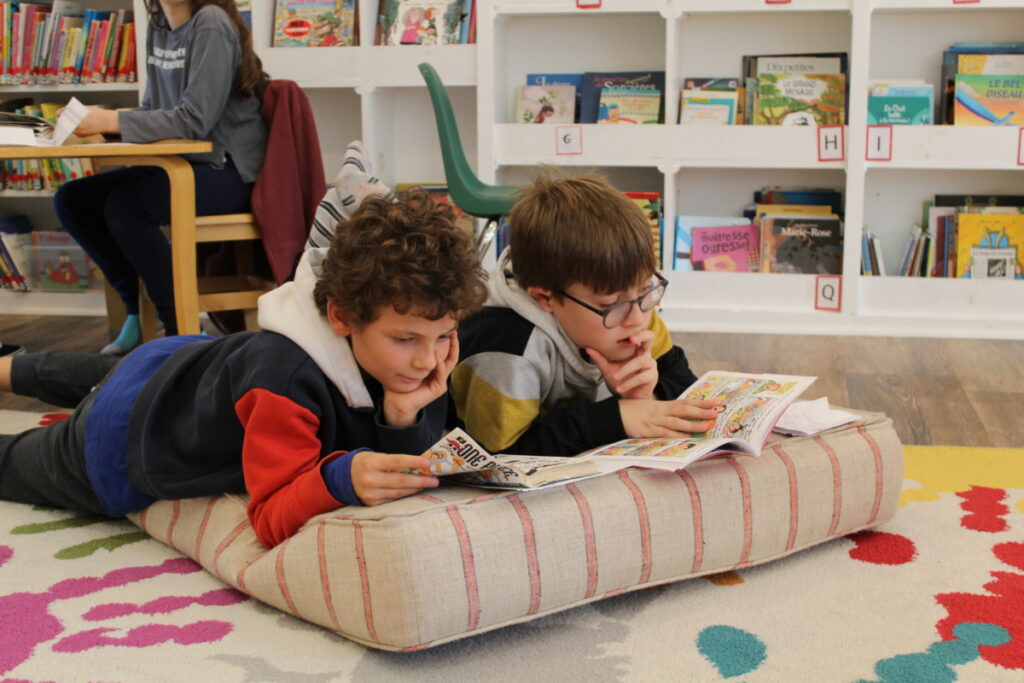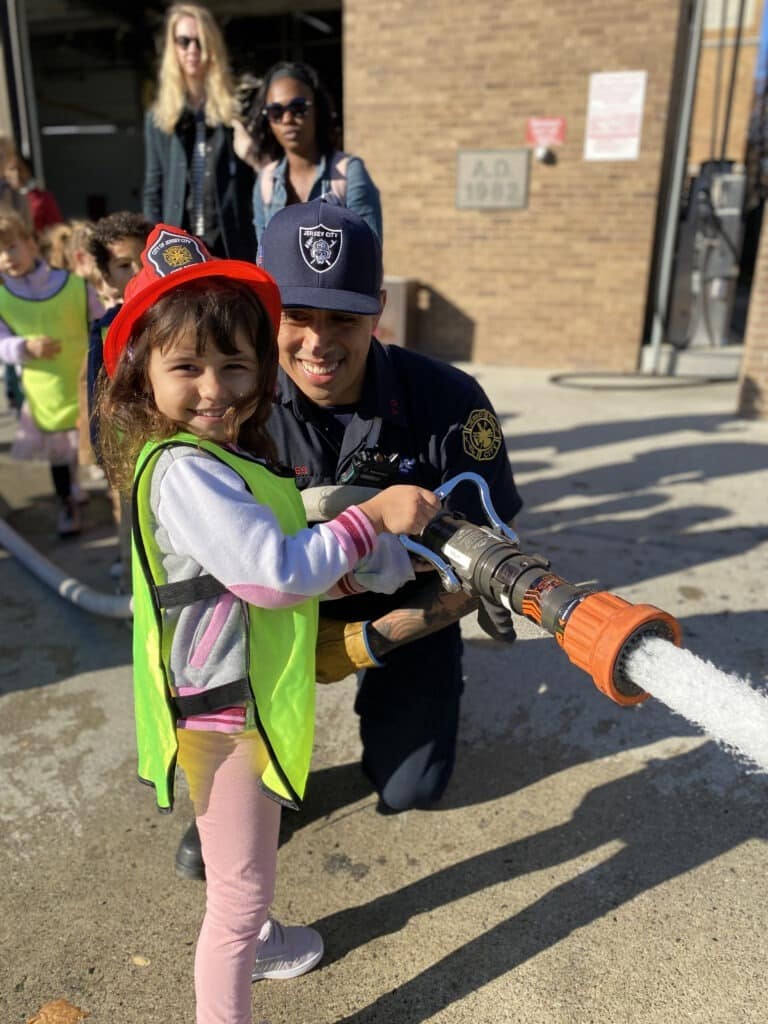Developing and refining motor skills is an essential component of child development. From the moment an infant starts grasping things in their chubby fists (a dangly earring, your nostrils and hair, their siblings’ toys…), they are improving their dexterity and building strength. This work continues naturally throughout their toddler years, through playing, drawing, eating, and exploring the world. Every act in which a child uses their eyes and fingers to grasp and move things contributes to their visual perception, spatial awareness, and dexterity. These attributes are crucial for helping children learn to use tools and build the strength they need to become more autonomous in daily activities such as dressing themselves, using utensils to feed themselves, and manipulating toys and other small objects.


The French Academic Approach to Handwriting
In preschool, work geared toward intentionally improving fine motor skills is a critical piece of the curriculum. In fact, in the French school system, a significant part of the academic progression from Pre-K2 to kindergarten is consciously designed to prepare children for cursive writing, which is a hallmark of our educational system. This contrasts with the American school system, in which cursive writing is introduced in the 3rd grade (if at all). In fact, many occupational therapists recommend learning cursive as it helps develop coordination, spatial reasoning, and fine motor skills.
PK2 and PK3
The gestures of the arm are refined as students learn to paint or draw smooth lines and curves. Children may work at an easel or a large whiteboard to practice holding their arm up as they work, developing increasing strength and control. From PK3, proper grip is introduced and reinforced when children use writing, painting, and drawing implements.
PK4
The focus gradually shifts towards developing and refining control of the hand. Students use smaller gestures as they practice coloring and drawing on smaller surfaces. They begin practicing capital letter formation, and graphisme is also introduced: forming designs and motifs, which at this point are quite simple, that require consistent motions and a steady hand. Children may create large designs and letters using playdough and by writing in cornmeal, sand, or even shaving cream using their fingers. They may also begin simple pencil control games and activities, such as completing a maze, keeping the line they draw within the path.
A simple maze like this one helps refine pencil control and visual awareness in Pre-K 4.
Kindergarten
Having started from the movements of the arm and continued to the gestures of the hand, children are ready to refine this work in kindergarten by practicing finer dexterity skills and pencil control. Graphisme designs become more complex, often with unbroken, curving lines that imitate cursive. The writer’s seat, placement of writing materials, and pencil grip are reinforced in each session. Students are given activities that reinforce manipulative skills with small objects, such as stringing beads on fine twine, moving beans with tweezers, and making designs on small pegboards.
In the second half of the kindergarten year, French teachers begin teaching cursive letters, building on all the pencil control practice, continuous graphisme exercises, and visual-spatial awareness that came before. By the end of kindergarten, our students are able to write their names and some simple words in cursive autonomously, and can write short sentences with a model.
These graphisme drawings practice connected cursive loops
The Writer’s Seat
Before continuing with advice about pencil grip, let’s pause to discuss the importance of a correct seat and posture for writing. When children are writing, they should be taught to “sit like writers”:
- The desk and chair should be at a comfortable height for the writer. In school, we have different sizes of tables and chairs; at home, you can adapt your furniture with bolsters and props.
- The knees and hips should be at 90 degree angles.
- The feet are flat on the floor. If this is not possible, a stable prop can be placed under the feet.
- The chair is pulled into the desk so that the writer’s arms can rest comfortably on the desk.
- The back is straight but slightly tipped forward towards the table.
- The dominant hand holds the pencil; the non-dominant hand is the “helping hand”, keeping the writing surface in place.
Instilling and reinforcing a correct writer’s seat provides the child with a stable base, allowing them to exercise more focus and control in their writing. While various activities in Pre-K and K allow children to sit or stand in different positions, we always reinforce the writer’s seat for writing activities.
When writing, the paper or whiteboard should be flat on the surface of the table. For a right-handed writer, it should be tilted slightly to the left, but a left-handed writer will tilt it to the right.
The Dynamic Tripod Grip
Appropriate pencil grip is a significant component of learning to write. Letters with curved lines, vertical and traced lines, or complex formations (such as all cursive letters, which the French school system incorporates in Kindergarten) are formed more accurately and fluidly when the fingertips can move to manipulate the writing tool. In both the French and American educational systems, we teach the dynamic tripod grip starting in Pre-K 3, as a child starts working with writing implements (crayons, pencils, paintbrushes, markers, etc).
In the dynamic tripod grip, the index finger and thumb pinch the pencil about 2 centimeters up from the tip, which rests on the middle finger below. (Some of my French colleagues refer to the thumb and index finger as a crab’s pincers, resting on the “pillow” of the middle finger.) The ring finger and pinky are stable on the table, forming a straight line with the wrist.
Note that left-handed students are also capable of writing with the tripod grip; the only difference in a left-handed grip is that they should pinch the pencil about 3 cm from the tip instead of 2. This will allow them to see what they’re writing and avoid needing to hook their wrists around their letters (ouch!). Left-handed students often need extra practice orienting the direction of their letters from left to right; it may feel more intuitive for them to work from right to left.
“Immature” pencil grasps, in which the fingertips do not move (for example, wrapping all four fingers around the pencil or gripping the pencil in a fist), make letter formation more awkward because the entire hand has to move to move the pencil. The writer sacrifices control and mobility with this static grip. They may grasp the writing implement too tightly, which causes fatigue, pain, and unnecessary stress on the joints. It can also slow the pace of writing down significantly: writing is not a race, but a child should be able to write at an appropriate rate for their development so that they can keep up with the class.
This student demonstrates the dynamic tripod grip.
Supporting fine motor skills at home
Children’s fine motor skills can be improved at home, to promote an easy transition to writing and other activities requiring finger strength and dexterity. You can set up activities, sensory boxes, and challenges which will help build coordination and muscles in a zero-pressure, fun environment. Here are some suggestions for at home activities.
Strength Building Activities
Developing hand strength helps children accomplish tasks with more control and stamina.
- Most children adore kneading, sculpting, rolling, and squeezing playdough. It’s a relaxing sensory experience, and the dough provides excellent resistance to build their finger strength. Making and playing with slime is another way to achieve the same benefits.
- You can set up a sensory bin with soapy water, sponges, and washcloths for your child to squeeze and play with. Throw a spray bottle in there as well, so they can practice squeezing the sprayer. If you don’t want to deal with the mess of a sensory bin, bath time will do as well!
- Play a gentle game of tug-of-war using a rope, towel, or rag – make sure your child holds on super tight while you pull.
- You can make stress balls using sand or beans and balloons, for your child to squeeze especially if they’re feeling anxious. Little bean bags or squishy toys serve the same purpose.
- Normal outdoor play – swinging on monkey bars, climbing trees, shoveling dirt, picking up sticks, collecting rocks, and more – will build hand strength as well as overall coordination and fitness.
- Many young children really want to be involved with their parents’ chores: ask your child to help carry a grocery bag, to stir dough, squeeze lemon or lime juice, or spray cleaning solution on the table.
- Try using syringes or eye droppers for an art project. The squeezing motion requires both strength and control.
Activities For Developing Fine Motor Skills
Fine motor skills activities frequently employ hand-eye coordination and a fine grip on small objects. Activities that encourage children to use both hands to complete a task are excellent for developing the dexterity needed for daily activities as your child ages.
1. Working with beads and string, which can become smaller as your child grows older, imitates the same type of fine grip they employ when holding a pencil. Many children enjoy stringing wooden beads following a pattern (an early math skill) or to make jewelry. As a precursor to using string, try a pipe cleaner or piece of uncooked spaghetti, which will hold its shape. Working with lacing cards can serve much the same purpose.
2. Popping bubble wrap (what kid doesn’t love that?) builds strength as well as coordination and dexterity.
3. Twisting nuts on and off bolts, and inserting keys into padlocks and twisting them, are both activities that build dexterity and require children to “tune into” the object they’re manipulating to successfully accomplish the task.
4. Put colored beads into a dish and ask your child to sort them by color into an egg carton or ice cube tray. The twist to make it more challenging: they need to use tweezers to do it! You can get large children’s tweezers for this purpose.
5. Accumulate some spare change, then ask your child to sort the corns, stack them up, and put them into the slot of a piggy bank.
6. Place clothespins on your child’s clothes, and have them look in a mirror to locate and remove all of them. Encourage your child to pinch the clothespins with their thumb and index finger, which mimics pencil grasp.
7. Cutting is an important skill for hand strength, spatial reasoning, and dexterity. Work with your child to snip out shapes and pictures from a magazine to make an artistic collage. It helps to draw a square or circle around an object they need to cut, until they’re more adept with scissors.
8. Finally, from around age 3, teach and encourage your child to write, color, draw, and paint using dynamic tripod grip. The best way to learn it is to do it!
Students who have more dexterity and strength in their fingers are able to approach writing and drawing class work with more confidence and focus. Engaging in fun, meaningful activities to build strength and coordination in your child’s hands and fingers helps set them up for success in preschool and kindergarten. Even better, as their fine motor skills develop they will approach increasingly difficult tasks with a sense of empowerment, helping them build autonomy and independence at a young age. In next month’s blog post, I will share even more tips for helping your child become autonomous as they transition from preschool to kindergarten.







